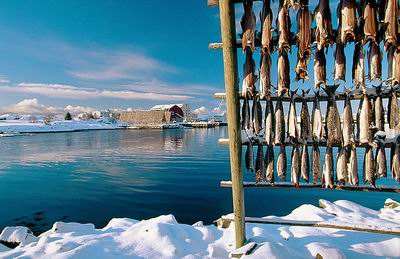By Tom McGregor, CCTV.com Panview commentator and editor
The Chinese are getting a stronger taste for seafood, especially for imported fish from the surrounding waters of Europe.
The European Union upholds one of the world's strictest standards on food safety, while the Chinese middle class and wealthy are willing to spend more on imported food.
The Nordic nations - Norway, Sweden and Finland - have held a long and rich history in the fisheries industry. The cold coastal waters are a rich breeding ground for salmon that have become popular for Chinese consumers.

(Photo from internet)
Yet, exporting an abundant supply of salmon to China and the Asia-Pacific region would not be sustainable unless Nordic seafood companies adapt by utilizing new technologies, such as a 4.0 intelligent support system.
Accordingly, Norwegian fisheries are setting up offshore ocean farming in cooperation with Chinese aquaculture-related companies.
1st-of-its-kind offshore fishing
Last Saturday, the state-owned China Shipbuilding Industry Corp. (CSIC) set sail for delivery from east China's port city, Qingdao, the first batch of intelligent offshore ocean farming facilities callled, Ocean Farm 1, to a Norwegian company, Kverva-based SalMar ASA.
The ocean farm will be located in Frahavet, off the coast of central Norway, and scheduled to start operations in the 2nd half of 2017.
Equipment with a total value of $US300 million would include the first offshore salmon farming equipment using semi-submersible installations that are usually used for the offshore oil & gas drilling sector.
The ocean farm will utilize advanced technologies, such as automatic fishing, hydro-logical monitoring, deep-sea positioning and biological light adjustment systems that will be placed in ocean waters 100-300-m. deep.
The facility is expected to have a 25-year lifespan and stand resistant to typhoon-strength storms with capacity to cultivate 1.5 million fish annually.
Global opportunities for aquaculture
Offshore fisheries have a number of advantages. Salmon are more healthy swimming in the ocean's currents, while only 3-7 full-time employees are needed to keep it operational.
"It is highly possible for more marine production companies from countries such as the United States, Canada, Denmark, Ireland and the United Kingdom to purchase such facilities if they can prove themselves reliable and advanced," Dong Liwan, professor at Shanghai Maritime University, told China Daily.
Dong added, "Leading Chinese shipyards are in a better position to compete with rivals in South Korea or Singapore, especially in the fields of ultra-deep water semi-submersible drilling rigs, manned submersibles."
Yang Zhigang, chairman of CSIC’s Wuchang Group, said the project combines the best of the Norwegian aquaculture industry with China's offshore engineering technologies and expertise.
Meanwhile, more Chinese equipment manufacturing companies are hoping to expand by tapping in the EU market.
Rising fortunes for China-Norway ties
Offshore fish farms may soon become trendy, since Chinese engineering firms can more easily convert equipment used by offshore oil & gas drilling rigs into submersible fisheries.
China's large appetite for seafood and Norway's huge supply of salmon have inspired closer ties between the two nations. Last month, Norwegian Prime Minister Erna Solberg led a trade delegation on a state visit to China.
PM Solberg was accompanied by senior executives working for major seafood companies, including Kongsberg Maritime AS, which has launched the world's first automated aquaculture facility.
The Kongsberg site has adapted systems: telecoms, positioning packages, cameras, echo sounders and sensors. The company has installed 3D fisheries in a vast water volume to ensure effective feeding, as reported by Maritime Executive.
Kongsberg has combined marine engineering, marine cybernetics and marine biology with a Big Data approach along with sensors and state-of-the-art aquaculture support systems.
Fishing for the agesThe fishing industry keeps changing with the times, since new technologies and methods continue to be upgraded. All those working in the sector must keep up with the latest advances to ensure there's plenty of supplies of seafood to catch and to sell to consumers worldwide.
Accordingly, Norway and China are working together to develop offshore fish farms to sell more salmon for hungry customers on a global scale.
(The opinions expressed here do not necessarily reflect the opinions of Panview or CCTV.com)

Panview offers a new window of understanding the world as well as China through the views, opinions, and analysis of experts. We also welcome outside submissions, so feel free to send in your own editorials to "globalopinion@vip.cntv.cn" for consideration.















